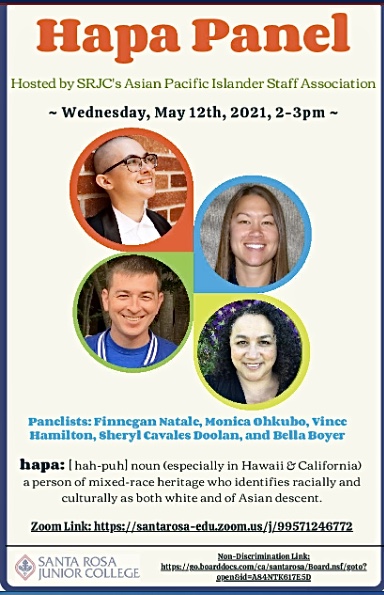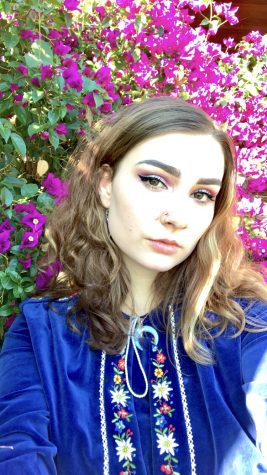
Santa Rosa Junior College’s Asian Pacific Islander Staff Association hosted a panel where mixed race students and faculty shared their experiences in light of Asian American Pacific Islander History and Heritage Month.
Hapa is a Hawaiian term originating in the derogatory phrase hapa haole, used to describe someone who was half Hawaiian and half white. Today the phrase hapa can refer to anyone who’s part Asian or Pacific Islander and part Caucasian. In addition, the meaning has become “half” or “mixed blood” including a variety of racial combinations.
Dr. Sheryl Cavales Doolan, SRJC English faculty member, brought up the question: what are you?
“The idea of multiracial folks having a lot of genetic diversity can lead to racial ambiguity. So when people see us, that’s often a question that comes up,” she said. When asking about one’s racial identity, it should be done in a positive and appropriate way; in a one-on-one situation, according to the panelists.
“I try to make an effort now, not to describe myself as being ‘half.’ There’s a great study where the title is, ‘Not Half But Double,’ referring to this idea that I’m not half of anything, that I’m fully me and I’m part of this,” Cavales Doolan said. “I’m part Filipino and I am part white and I am part Greek and I am part of all of those things.”
Monica Ohkubo, SRJC Pre-Sports Medicine Program Director, said she loves visiting Hawaii because she feels she belongs there. One time while visiting, she dropped her ID on the ground. “I didn’t realize until a couple blocks that I dropped it and then I went back and it was gone and so in my mind I was like, that’s why I like it here,” she said. “Because probably half the population could pick up my ID and use it, whereas if I dropped that in the middle of Rohnert Park no one could use it.”
Vincent Hamilton, SRJC counselor, said, “When I was an undergrad, 20 years ago now, I was really fortunate to be part of a group at UC Berkeley, it was called the Hapa Issues Forum.” The panel held on Wednesday hoped to introduce multiracial student identity resources and research as well as create a space to share stories and experiences.
Hamilton is mixed race, however, on paper you wouldn’t know he’s just as much Okinawan as he is Caucasian. When Hamilton was born, his grandmother wondered why he didn’t have a Japanese middle name. “I think in a lot of ways, my mother was kind of downplaying my Asian side a little bit because just historically, you know, the Japanese were interned, I have family that was interned during World War II,” he said.
Hamilton’s parents were not hapas themselves but raised a mixed race child. “My father is completely Caucasian, my mother’s completely Okinawan, and so we didn’t in my household talk a whole lot explicitly about my cultural identity,” he said. “It was something that I very much figured out for myself when I moved out of the house, when I went to college.”
The panelists spoke out about their struggles with identity and acceptance as hapas. Finnegan Natale, an SRJC student who uses they/them pronouns, said they watch a lot of Japanese anime to try and connect with their culture. “I always feel kind of like this outsider trying to reconnect to something that my family once was generations ago, but then I really don’t know anything at all about it,” they said.
Natale’s family were forced into assimilation as well, as their grandmother was interned at a young age. “My grandmother has seven sisters and an older brother, and she was very young when internment started. So her brother renamed all of them with American names,” they said. Natale’s grandmother grew up believing her own name was Dorothy when in fact she was given a Japanese name at birth.
“So my grandmother and all of her sisters have an American name that they go by 99% of the time, and then a Japanese name that was the one their parents gave them but they didn’t really connect with because of how young they were when their names changed,” they said.
“And then me as a transgender person, there’s that process of you know, trying to find your new name, and there was this very, kind of muted part of me that wanted to choose a Japanese name,” Natale said. They always kind of felt like they weren’t Asian enough. “Like I don’t look Asian enough where it would be like me having a Japanese name wouldn’t be seen as some fetishized thing, so I went with Finnegan.”
Bella Boyer, SRJC student, grew up in Hawaii in a predominantly Asian space, yet still felt like an outsider because of her white heritage. “I felt like being white was the butt of the joke sometimes. So you had to kind of be a little bit on defense about your white heritage,” she said.
When Boyer moved to California, she had a similar experience. “I was only ever identified as Asian. Here I’m not white, but in Hawaii they could only see that, you know, I was part white.” Boyer is no stranger to the rice stereotype; when visiting her Caucasian family or talking to Californians, “They say things like, ‘We made rice for you because we know that you guys like that stuff.’ Or like here, people will ask me, ‘How do you make rice?’”
Hamilton’s experience in a student hapa forum changed his life. Starting a hapa group at SRJC has been a dream for him. He hopes that awareness will bring opportunities and the Asian Pacific Islander Staff Association is here to support the college in providing them.
SRJC President Dr. Frank Chong later commented, “I think we have a lot of hapa students here and staff and faculty, and I think it’s a wonderful opportunity for them to explore their own sense of community and identity.”



